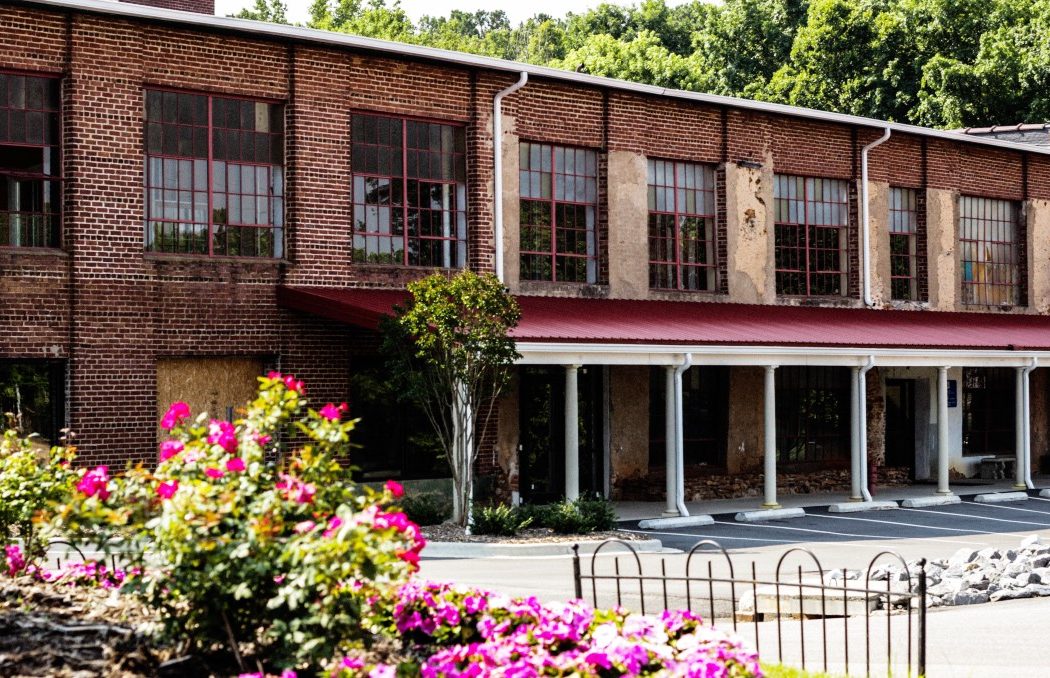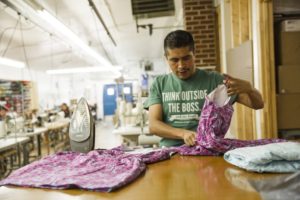This Feature Article for REVITALIZATION was written by
Molly Hemstreet, Sara Chester, and Paul Castelloe.
Alfonso works at a mid-sized textile manufacturing firm, Opportunity Threads, in Morganton, North Carolina. Alfonso, who is 26, joined Opportunity Threads in 2011 as a fabric cutter.
He immigrated to the US when he was 16, leaving the economic challenges of war-weary Guatemala. Before joining Opportunity Threads, he had inconsistent employment that only allowed him to work a few days a week.
At Opportunity Threads, he became a leader in the business; he has had a significant increase in wages; and he and his family just bought their first home.Alfonso and his family have moved out of poverty, into economic stability. And now they are able to give back to their community. They give money and time to their children’s schools, to their church. They play in local recreational soccer leagues. They live rich, meaningful, productive lives.
Textile manufacturing jobs left Western North Carolina in droves over the past 20 years. Growing up in Morganton, Molly Hemstreet watched the economic unraveling of her community and wanted to explore a business model where industrial work was not so easily extracted. She started Opportunity Threads, a cut-and-sew textile firm, in 2008.
Opportunity Threads is now one of the strongest worker-owned, immigrant-led manufacturing firms in the United States. The firm started with only two employees and has expanded to 23 full-time workers, growing to $1.2 million in sales and leveraging $8 million in client sales.
Worker-owned manufacturing firms create good jobs
Workers at Opportunity Threads have the opportunity to buy into the company and manage the business on a day-to-day basis. Everyone at Opportunity Threads is hired with the expectation of becoming a worker-owner. Worker-ownership means that if a worker stays on at Opportunity Threads, they are given the opportunity to be an owner in the company. They are voted in by the members of Opportunity Threads after a vetting process of 12-18 months.
Ultimately the workers themselves and their families are the beneficiaries of the success and growth of the business. Each member-owner buys into the company and has an equal vote in the business’s decisions. Everyone who works at Opportunity Threads is paid a living wage.
Opportunity Threads can be seen as a “best practices showcase” or “innovation lab” for creating good, high-quality manufacturing jobs. Many workers at Opportunity Threads had a previous work history where they moved from one bad job to another. Bad jobs are characterized by inadequate, irregular pay and near-constant instability: part-time work, seasonal work, variable hours, unpredictable schedules, and wage theft. Bad jobs lead to poor health outcomes, high stress, and low self-worth. Good jobs, on the other hand, signal a move from economic instability to stability.
Good jobs provide a living wage, consistent and predictable hours, and strong safety standards. Good jobs encourage workers to have a level of control over their work, and to contribute the larger purpose of the business. Good jobs may also include access to financial literacy and financial planning, homeownership counseling, and a company-sponsored emergency loan fund. Good jobs seek input from employees; thus the ultimate expression of democracy in the workplace may be worker-ownership, where workers have ownership and control of the business, its decision-making, and its growth.
“Sewing” the seeds for a broader vision
 In some ways, Opportunity Threads is unique, and it has been recognized for its uniqueness. In 2016, Opportunity Threads was named Co-op of the Year by The US Federation of Worker Cooperatives. Largely thanks to Opportunity Threads, Western North Carolina is now considered to be a national hotbed of growth and creativity related to worker ownership. Yet in other ways, Opportunity Threads is not at all unique. Opportunity Threads could stand in for any small-to-midsize textile manufacturing firm in Any Town, Rural USA.
In some ways, Opportunity Threads is unique, and it has been recognized for its uniqueness. In 2016, Opportunity Threads was named Co-op of the Year by The US Federation of Worker Cooperatives. Largely thanks to Opportunity Threads, Western North Carolina is now considered to be a national hotbed of growth and creativity related to worker ownership. Yet in other ways, Opportunity Threads is not at all unique. Opportunity Threads could stand in for any small-to-midsize textile manufacturing firm in Any Town, Rural USA.
The real power of this story is the bringing together of many interrelated textile manufacturing firms to form a value chain network, the Carolina Textile District, which currently has 15 members representing 400 employees. And it is the weaving together of these individual manufacturing firms that gives the larger story of The Carolina Textile District and The Industrial Commons its lasting power: a vision of 3,000 workers in 50 firms across the Southeast with high quality jobs and good lives, all organized to build and share a competitive advantage and have a collective voice for their industry.
Cultivating a value chain

Tanya Wade, Project Coordinator for the Carolina Textile District, and Doris Houston look over potential work contracts.
As Opportunity Threads grew over the years, its demand began to eclipse its capacity. Rather than keep its store of production orders to itself, Opportunity Threads decided to share its success with other regional producers. Rather than see other regional producers as potential competitors, Opportunity Threads chose to see them as potential partners and collaborators.
Opportunity Threads turned to the Manufacturing Solutions Center and Burke Development Incorporated to brainstorm ways in which excess demand could be dispersed to other regional textile manufacturing firms across North Carolina. These early brainstorming sessions eventually spurred the development of The Carolina Textile District.
“Value chain networks coordinate demand and build voice, revitalizing our heritage industries in a way that builds on local people and regional assets,” says Sara Chester, Burke County Economic Development Corporation.
The District

Libby O’Bryan, owner of Western Carolina Sewing Company (Sew Co.) and Network Coordinator for the Carolina Textile District.
The Carolina Textile District (The District) operates as a value chain network. A value chain network is a coordinated network of people, businesses, and organizations that address a market opportunity to meet demand for specific products or services – each advancing individual self-interest while together building rooted local and regional wealth. It is an old concept made new again, as many good ideas are.
The basic purpose of a value chain network is to strategically link traditional “supply chain” partners together through a coordinated, nimble, yet autonomous network. Entities in the value chain network are not just linked together for the purposes of having products made; they are also connected through shared values and shared resources. The value chain network plays the role of understanding and aggregating demand that gets work to the manufacturers or producers in the network.
Through its comprehensive database of textile-related manufacturing companies, The Carolina Textile District catalogues each company’s products, services, capabilities, minimums, and pricing structures. The District then assists clients who wish to have a sewn-goods product made domestically by analyzing their production needs and pairing them with appropriate members (often several) in the value chain network.
As one example, a client came to The District for assistance with an organic fleece sweatshirt. The District’s Project Specialist was able to find a partner that was willing to make the fabric from US organic cotton. The cotton was spun, knit and finished in North Carolina. A District partner in South Carolina made the design and corresponding patterns. It was then passed to Opportunity Threads for cut and sew production and finally dyed and printed at TS Designs, a District partner in North Carolina. Along the way, not only did partners keep each other informed, but the partners made sure they were problem solving each step of the way.
Manufacturers in the value chain network are linked together not only for the purposes of production but also because they are connected through shared values, services, and tools. In fall 2016, The District hired a Network Coordinator to hear the needs of The District’s partners and their workers so that The District can build collective support and industry voice. We have plans for even deeper collaboration around shared contracts and co-branding initiatives. Members of The District will begin sharing equipment in 2017. The values-aligned manufacturers that make up The Carolina District also have long-term plans for a federation model where they collectively advocate for workers and support policy initiatives that favor industry and employees.
Crafted production
The main form of market demand that The Carolina Textile District’s founders saw were entrepreneurs already committed to domestic production that wanted locally sourced materials and needed to start with “small runs” of production. They routinely want to customize their work by color, size or piece. The Carolina Textile District refers to this approach to textile production as crafted production.
Crafted production represents a segment of modern, domestic manufacturing demand. It focuses on customization and quality over quantity, and it is responsive to clients’ needs. Crafted production is also based on a direct-to-consumer shift in production, marketing, and sales.
More companies are selling their products directly to consumers through websites, rather than indirectly to consumers through retail stores. As more purchases are made online, brands have more flexibility in their margins to afford US production. This usually means they need tightly controlled inventory, customized products, and a quick turnaround time.
Millennial-friendly manufacturing

Kip Veno fabricates a metal plate for an electric material handling vehicle manufactured at TCI Machinery in Gastonia, NC.
The Carolina Textile District started to capture and analyze data on the kinds of modern demand it was seeing in its emerging value chain work. After processing over 1,200 requests for production of sewn goods, the District’s team discovered that entrepreneurs interested in launching new domestically manufactured products tend to be young (67% under the age of 40).
Most are also committed to domestic US sourcing and production, to working with manufacturers that pay fair wages, and to working with manufacturers that aim to create jobs in the US. These business goals fit well with the way Millennials tend to view the world of work.
The heart of our goal is to develop competitive and profitable manufacturing firms, which in turn develop high-quality jobs for industrial workers and root wealth in local, rural communities. Yet equally important to our long-term vision is the building of collective voice and power across multiple industrial sectors: We envision a new Southern labor movement of autonomous industrial shops that are strategically linked with collective power, common voice, and strong democratic workplace cultures and values.
This vision of merging profitable manufacturing firms, high quality jobs, democratic workplaces, and collective power among manufacturing workers has been realized in other parts of the world, such as Italy’s Emilia Romagna.
The Industrial Commons
To expand this vision, we developed a nonprofit organization called The Industrial Commons (The Commons). The idea at the heart of The Commons is that worker-owned firms can be successful when they are strategically integrated into value chain networks and provided with industrial and technological innovation.
We then broadened this vision in two ways:
- By providing education and support around value chain development, worker ownership, high quality jobs, and crafted production to other manufacturing sectors.
- By providing education and support to businesses that are considering converting to worker ownership.
We believe that the Carolina Textile District could be replicated (with the proper support systems) in other industries. The heart and soul of The Carolina Textile District is not textile manufacturing; rather, it’s the idea that relatively small manufacturing firms can come together to form a value chain network, create good jobs that root wealth locally, and build collective power for workers across a region.
Education and support for conversion to worker ownership

Leslie McKesson from Western Piedmont Community College speaks to the need of better jobs and opportunity in the rural Western North Carolina at 2016 Think Tank Day in Morganton.
We also broadened our focus beyond manufacturing firms to include locally-rooted businesses of all kinds that might be interested in worker ownership. This work emerged as we followed the energy of the people we were working with.
We found that people both within and outside of manufacturing industries were asking us for more information on worker ownership and how a conventional business might convert to worker ownership.
We had also been working with the NC Justice Center, which recently published a report showing that North Carolina has a particularly large number of business owners nearing retirement age, and that converting those businesses to worker ownership structures might be a potential way of preserving the jobs that those businesses bring to local communities.
In response to local businesses’ interest and our work with the Justice Center, The Commons began a series of Worker Ownership classes. These have provided training and consultation for around 25 businesses so far; of these, four are converting to worker ownership and five others are considering conversion.
Theory of change
The joint work of the Carolina Textile District and The Industrial Commons is based on a theory of change, comprises the following ideas:
- Organized, creative workers build out competitive firms, which provide good jobs and good lives. Our theory of change begins with workers who are networked, creative, and organized. These workers build out competitive manufacturing firms that provide good jobs, jobs where workers have stability, choice, and opportunities. High quality jobs can change workers’ lives for the better.
- These firms build out industry-specific value chain networks, which coordinate demand and build voice. One manufacturing firm that provides good jobs is important. But when a firm comes together with others to form a value chain network, the impacts can be broader and deeper. The Carolina Textile District is a value chain network that has two goals: to organize demand and supply to that partner firms can be more competitive, and to build collective power, voice, and support for the industry.
- These networks collaborate to create locally-rooted economies that benefit everyone.
It is our long-term vision that organized workers, competitive firms, and value chain networks in multiple sectors and multiple communities could potentially create vast and transformative impacts for rural communities.
We envision organized workers, competitive firms, resilient networks, and industry-focused support systems that are rooting economic change in local communities across our region.
This theory of change is carried out through three core strategies and a core value:
- Strategy 1 Harness industry knowledge to give small- to mid-size firms a competitive advantage. Manufacturing is so technical that emerging firms need support organizations with years of experience in the industry. Manufacturing Solutions Center played this role in Western NC.
- Strategy 2 Support more equitable business models that create locally owned wealth. Worker ownership provides manufacturing firms with a model for creating high quality jobs. Worker owned businesses also provide a means of securing fair wages and benefits for workers.
- Strategy 3 Construct value chain networks to aggregate demand and organize producers. Value chain networks can organize demand for manufacturing firms, thus making them more competitive. They can also serve as a collective voice for industry firms and workers.
A value: Integrate the strategies above while doing all of this work from a value of “coopetition.” In a value chain network, firms cooperate and collaborate to become more competitive globally.
We are working with folks in the foothills of Western North Carolina to re-imagine, re-shore, and re-invent textile manufacturing in rural communities. We are melding innovative concepts and practices: worker-ownership, good jobs, value chain networks, crafted production, and Millennial-friendly manufacturing.
We believe we can harness our region’s manufacturing past to create a new, more equitable economy. But it must be done differently. This new way of working puts workers at the center of competitive firms, which are supported in creating innovative products and implementing democratic models that are good for people and communities.
Manufacturing becomes the hub of diverse, healthy, thriving communities. Through manufacturing, people create shared meaning, purpose, equity, and wholeness.
Another world is possible. She is on her way. One a quiet day, we can hear her breathing.
Featured photo (courtesy of BDI) shows the Historic Waldensian Mill in the heart of downtown Valdese. The recently-revitalized textile mill has 30,000 square feet of finished and unfinished space available. All other photos courtesy of The Industrial Commons.
See the Industrial Commons website.
Read the full version of the Opportunity Threads case study (PDF).






